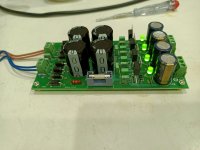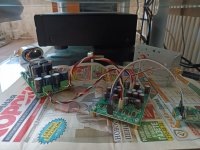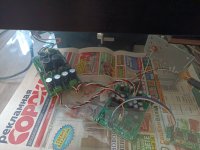Its playing with the D1 now maybee a little much energy in the top,but definitely a step up from the opamps.

I didn't find any kit here.@tamra , any SD card player kit at Akihabara or elsewhere in Japan, please ?
Only someone made SD player.
http://www.tachyon.co.jp/~sichoya/SDTrans/SDTrans6.html
https://www.chiaki.cc/Transport/sdtrans192.html
For me it's the best of its kind. Started with a QLS git it highly modified & thought it's real good but when I bought the SD Trans 384 it really killed the QLS even on single 5V supply but after going individual supplies on the Sd Trans it got even better.I didn't find any kit here.
Only someone made SD player.
http://www.tachyon.co.jp/~sichoya/SDTrans/SDTrans6.html
https://www.chiaki.cc/Transport/sdtrans192.html
.... the SD Trans 384 it really killed the QLS ...
I guess the question many of us will have about SD Card players will be just how do they sound in comparison to the usual USB feed?
The "digital turntable SD player" would have to do something very special to the sound quality, to beat all the DSP enhancements available with usual USB playback. DSP's can give as big a sound improvement as a major hardware upgrade. Upsampling with PGGB, EQ, phase and room correction, stereo width control etc would be hard to give up. However for the fastidious those DSP's could be applied to an album and saved as a massive WAV file on an SD card.
Has anyone compared an SD Card player to a USB-I2S feed?
Last edited:
Kazap, my feeling is majority of people does not use all the IR and FIR function from these ad'ons in their AMR renderers.
The quality of the feeded front end signal matters a lot too.
Fifos or async do not fix all. Hence my questions. My thougths though just non technical intuition, was SD reader was less polluted gnd, low EMC EMI, short ground loops in the digital front end...but I have damn any idea.
My main dac has a complicated front end and it is too bulky...flat antena. Amr based NAS with usb output into an Async XMos (Wave i/o) then fifo then master clock then Dac...a lot of traffo secondaries to feed them all...
The quality of the feeded front end signal matters a lot too.
Fifos or async do not fix all. Hence my questions. My thougths though just non technical intuition, was SD reader was less polluted gnd, low EMC EMI, short ground loops in the digital front end...but I have damn any idea.
My main dac has a complicated front end and it is too bulky...flat antena. Amr based NAS with usb output into an Async XMos (Wave i/o) then fifo then master clock then Dac...a lot of traffo secondaries to feed them all...
Last edited:
Guys, I start today DAC 1702, I already checked PSU voltage, all connecting but no sound only silence. What I should do?
I don't populate smd's C31/36. I install OPA134PA.
I don't populate smd's C31/36. I install OPA134PA.
Attachments
Last edited:
@sworder84 You are first who completed this PCB, I hope there is no mistake on the PCB or schematic 🤔 I already double checked the design and it looks good (only pin 8 in the I2S header is not connected to the GND, but you are not using it, this pin can be soldered together with pin 7 if someone needs GND on pin 8).
Resolder all solder joints on your PCB: #4354 -- zoom it and you will see how many "potentially" cold joints there are. Heat the pins on the PCB well with your solder iron. The same problem may be on shift registers 😉
Resolder all solder joints on your PCB: #4354 -- zoom it and you will see how many "potentially" cold joints there are. Heat the pins on the PCB well with your solder iron. The same problem may be on shift registers 😉
same here, no sound come out, i checked all +/- voltage all correct, so i change the bit and sample rate to 16/44.1, but still no sound.Guys, I start today DAC 1702, I already checked PSU voltage, all connecting but no sound only silence. What I should do?
I don't populate smd's C31/36. I install OPA134PA.
And? How does it sound? What is the second Miro DAC on the right?but pcm63 wo to ks perfect. View attachment 1071163
Last edited:
So there are no glitches ?but pcm63 wo to ks perfect.
I'm still waiting for all the parts
type wrong, *works perfect.
@ skrstic - right hand side is 1865, 63 and 1865 both sound great,
@ mikorist - no glitches.
@ skrstic - right hand side is 1865, 63 and 1865 both sound great,
@ mikorist - no glitches.
Thanks chi0001 for the quick reply. Can you compare the sound of the PCM63 to the sound of the AD1865 when PCM63 plays a bit?type wrong, *works perfect.
@ skrstic - right hand side is 1865, 63 and 1865 both sound great,
@ mikorist - no glitches.
There is a problem with shift registers. I already check them with points (DL, DR and ground) - signal is not coming from them. Maybe one on them is defective?@sworder84 You are first who completed this PCB, I hope there is no mistake on the PCB or schematic 🤔 I already double checked the design and it looks good (only pin 8 in the I2S header is not connected to the GND, but you are not using it, this pin can be soldered together with pin 7 if someone needs GND on pin 8).
Resolder all solder joints on your PCB: #4354 -- zoom it and you will see how many "potentially" cold joints there are. Heat the pins on the PCB well with your solder iron. The same problem may be on shift registers 😉
sure skrstic, 1865 sound beautiful when you play any kind of music, bass is full of shape, 63 plays groovy, funky...... music is a best choice.
subjective feeling,
if i have time, i will go back to my parents home, i remember one of my cd player is 170x, let me watch or messure all pins output that is it missing something on the circuit,
subjective feeling,
if i have time, i will go back to my parents home, i remember one of my cd player is 170x, let me watch or messure all pins output that is it missing something on the circuit,
I look at the solder places and parts a hundred times... That's why it goes very slowly - plus I solder with Cardas tin. Every solder joint must look like it came from the factory. 😬
- Home
- Source & Line
- Digital Line Level
- DAC AD1862: Almost THT, I2S input, NOS, R-2R


